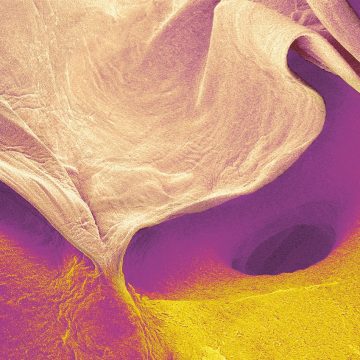Quantum
When it comes to the future of energy, one Cambridge team is using quantum physics to turn theory into – game-changing – practice.
If you want answers to the big challenges posed by efficient energy, you have to think… small. Atoms and particles small. And quantum physics takes us there, to the fundamental building blocks of nature. This quantum world explains the very basics of how everything works – down to the nature of the particles that make up matter and the forces with which they interact – and a team at the Cavendish Laboratory believes it could unlock the secrets of future materials for the generation, storage, transmission and efficient use of energy.
But first you have to get that energy to the right places – and the further you transport electricity, the bigger the losses you incur on the way. “Alternative energy is most abundant in places such as the desert or the coast, whereas the most energy-hungry places are dense, urban locations,” says condensed matter physicist Professor Suchitra Sebastian, Professor of Physics at the Maxwell Centre. “It is a bottleneck that will have to be addressed if we are to move further towards renewables.”

The answer lies in quantum physics, says Sebastian. Her research focuses on creating new quantum phases; she searches for these exotic states of matter at extremes of temperature and pressure or in very strong magnetic fields. Even ordinary materials start to behave very differently when under these extremes, she points out.
Sebastian’s team is hoping that they can develop novel materials to help us get energy from where it is created to where it is needed. Her team has taken magnetic materials and subjected them to intense pressure between the tips of a diamond anvil to transform them into superconductors – materials with zero resistance to the flow of electricity. “It is quantum alchemy,” she says. “You change the conditions and things start taking on a wildly different behaviour. If you take an insulator and squeeze it very hard it can transform into a conducting metal or even a superconductor. It is not because the constituents have changed, but because the way they are self-organising has changed.
… It is similar to the collective behaviour you see in murmurations of swallows, where collectively they shape-shift and a new form emerges
“Superconducting materials can transport energy over long distances without loss. And they can also help the world reduce energy use in the first place. They can levitate over magnets, for example, which creates the potential for magnetically levitated trains or electrical aircraft that use lightweight superconducting motors without ball bearings.”
But creating new superconducting materials or even more exotic quantum phases of matter is far from easy. “We understand how a single electron behaves, but a milligram of these materials contains 1023 electrons and every one of them is interacting with every other one. It is similar to the collective behaviour you see in murmurations of swallows, where collectively they shape-shift and a new form emerges. That potential for completely unimagined forms of physics to emerge is what makes it so exciting.”
For most of the devices and systems that we rely on in our daily lives, such as computers, electricity grids, solar cells or batteries, the efficiency with which energy is used, transmitted or stored is still significantly lower than what, based on established physical limits, is theoretically possible. Which makes batteries another obvious area for the Cavendish team to concentrate on.
The potential for completely unimagined forms of physics to emerge is what makes it so exciting
Lithium-ion batteries have been commercialised since the 1990s and have since become the workhorse for portable electronic devices such as smartphones. However, the increasing number of applications requiring higher power or larger devices, such as electric vehicles or renewable energy storage, means new materials are needed, particularly for the positive electrode.
Professor Siân Dutton, Professor of Physics and Solid State Chemistry at the Cavendish, has turned to the quantum world for answers. “We are developing new materials for use in rechargeable batteries, for example, that have higher capacity, energy densities and charge rates than existing materials,” says Dutton. “We are using our understanding of quantum physics to tune the electronic structure of the material.”

Dutton’s group is working on the next generation of batteries, using new materials with a wide range of novel properties such as superconductivity and thermoelectricity. The research has a number of strands, but includes making complex derivatives of known electrode materials or carrying out targeted searches for new candidate materials.
Many existing lithium-ion batteries use electrodes made from lithium cobalt oxide, but their high cost, toxicity, instability and low energy densities mean battery manufacturers are looking for alternatives. One of Dutton’s recent projects looked at a group of materials called pyroborates, where the cobalt in the electrode is replaced by boron. The research has shown promise for high-capacity, high-rate electrodes.
Another promising candidate uses magnesium instead of lithium. This potentially offers higher energy densities, stabilises the battery materials in the atmosphere, and reduces costs, since magnesium is more than a thousand times more abundant than lithium in the Earth’s crust.
We understand how a single electron behaves, but a milligram of these materials contains trillions of electrons, every one interacting with every other one…
To understand how novel materials might work in practice inside batteries, Dutton’s group is using quantum magnetism to probe what is happening to the charged particles inside them in a far more sensitive way. “We have been able to show that we can use measurements of the magnetic moment to get a very fine level of detail on the state of charge in our materials and the arrangement of those materials,” says Dutton. “Potentially these have high capacity,but there are real challenges in getting them to work.”
Elsewhere at the Cavendish, Dr Louise Hirst, Assistant Professor in the Department of Physics and the Department of Materials Science and Metallurgy, is proving that it’s not only on Earth that we need to make our means of generating and storing energy better. Her team works on power systems for the next generation of spacecraft, studying the complete technology path from simulating devices, designing them, growing the materials, fabricating cells and exposing them to radiation.
The high levels of radiation in space and the fact that you need very lightweight materials to make them commercially viable to put into orbit mean these systems are very different from the equivalent used in our day-to-day lives – in the solar panels on our houses, for example. She is working with novel semiconductor alloys – such as gallium arsenide and gallium nitride – instead of the silicon-based materials typically used in terrestrial applications.
Since getting things into space is so expensive, Hirst’s novel solar cells are built on ultrathin geometries – on the scale of 100 nanometres, a thousandth of the size of a human hair – rather than the micron scale of Earth-based solar cells. This is because in space, photovoltaic devices are bombarded with high energy charged particles that introduce defects into the absorbing semiconductor material, severely degrading the device’s performance. Thinner materials means fewer defects.
“When you use material on these ultrathin scales, things get very interesting and the materials start acting differently from the way they react in traditional solar cells,” says Hirst. “At this quantum level, light needs to be thought of as individual packets of energy – photons – rather than the wavelike nature we encounter in everyday situations.”
It really is a sleeping giant. We are a halfway house between academia and industry; there is the expectation that the new materials will reach the commercial market in time
Hirst aims to demystify the applications of quantum physics that, she says, we accept without question in everyday life. “The solar cells we use to generate a growing proportion of energy, the microprocessors we use in our devices and even the fact that the Sun shines, all depend on something called quantum tunnelling, where particles can simply pass through energy barriers they don’t – or shouldn’t – have the energy to surmount. The explanation of how it works sounds counter-intuitive but our very existence means it happens.”
Much of the work around solar cells involves trying to increase the efficiency with which photovoltaic materials convert sunlight into electricity. But the natural world puts a limit – the Shockley-Queisser limit – on just how good simple solar cells can be, allowing them only to convert around a third of the sunlight that falls on them. There are clever ways to circumvent this, however, by concentrating the light before it hits the solar panel or by sandwiching together different materials to absorb different parts of the solar spectrum.

“We are getting close to 50 per cent efficiency for these multijunction panels, which is amazing,” says Hirst, who expects her work in the space environment to trickle down to more down-to-earth projects. “It really is a sleeping giant. We are a halfway house between academia and industry, and although we’re at an early stage of research into new materials, there is the expectation that they will reach the commercial market in time.”
Dr Bartomeu Monserrat, Winton Advanced Research Fellow and a lecturer in computational materials science, is working on topological materials for designing low-power electronics – “computers that don’t heat up when you use them” – and novel organic semiconductors that exhibit “singlet fission”, which could help break the Shockley-Queisser limit of conventional solar cells and push efficiencies above 30 per cent.
The modelling of these complex quantum systems requires enormous supercomputing power. “Modelling materials (using either quantum mechanics or machine learning) is computationally very expensive,” says Monserrat, “and the only way we can scan over thousands of compounds to identify the optimal ones for technological applications is using the largest supercomputers on Earth. These include hundreds of thousands of central processing units, and also novel architectures like graphics processing units.”
So, while energy – and how to store and transport it – looks set to be one of the big global problems of the 50 years, it is at the opposite end of the size spectrum, in the mysterious world of quantum physics, that the answers to these problems may well be found. And the researchers from the Cavendish Laboratory are on track to find them.
Find out more about the Cavendish Laboratory’s work.







